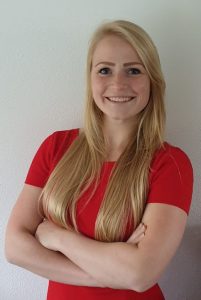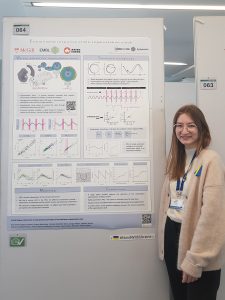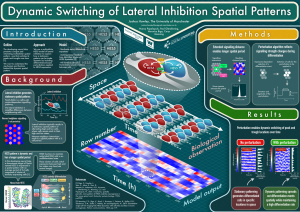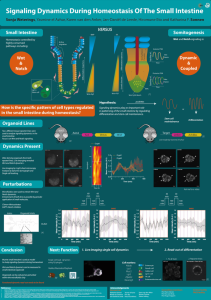Poster prize winners of ‘Biological oscillators: design, mechanism and function’
A buzzing helix at The Advanced Training Centre. Scientists holding a beer or a soft drink, pointing at the poster, discussing, laughing. It might have been a bit awkward initially, but soon enough it felt like the old days. And not only was it fun to be around peers again, but the organisers were also highly pleased with the exceptional quality of the posters.
Out of 107 onsite participants and 52 posters, four won an award for best poster by popular vote. We would like to introduce to you the winners and their research:
- Katharina Sonnen / Sonja Weterings, Hubrecht Institute, the Netherlands
- Victoria Mochulska, McGill University, Canada
- Laurent Jutras-Dubé, McGill University, Canada & Joshua Hawley, the University of Manchester, UK

Signaling dynamics in the homeostasis of the small intestine
Sonja Weterings / Katharina Sonnen, Hubrecht Institute, the Netherlands

The first in-person meeting I have attended in 2 years has just finished #EESBioOsc. It was great to see everyone and discuss all the exciting work over a beer.
And I am extremely proud of Sonja Weterings from the lab who won the poster prize.— Ina Sonnen (@SonnenKatharina) March 9, 2022
Abstract:
How information is transmitted between cells to govern development and tissue homeostasis in time and space remains a central question in biology. In particular, the role of signaling dynamics in this control is still largely unknown. While signalling dynamics during embryonic development have been studied extensively, such as in the control of mesoderm segmentation, the role of signalling dynamics in adult tissue is less well
understood. In the small intestine, a network of multiple signalling pathways coordinates homeostasis of the tissue. Here, I will present our latest findings on signalling dynamics in
the small intestine.
Modelling the entrainment response of the somite segmentation clock
Victoria Mochulska, McGill University

Abstract
In this study, a coarse-graining, entrainment approach is used to gain new insights into the dynamic properties of vertebrate segmentation clock from dynamical systems perspective. We entrain the mouse segmentation clock to various periods and extract information about the dynamic phase-locking behaviour, including the range of entrainment periods, entrainment phase, and the convergence route towards the entrainment phase. Using the entrainment quantification data, we derive the segmentation clock phase response curve (PRC). The inference of the PRC reveals two properties: a highly asymmetrical, mainly negative PRC, and an adjustment of the intrinsic period during entrainment.
We next construct a minimal model of the segmentation clock. We build upon the simplest non-linear phase oscillator, the classical Radial Isochron Cycle (RIC). We perturb it into an Elliptic Radial Isochron Cycle with Acceleration or ERICA. We then use Monte Carlo optimization to find parameters best fitting the experimental PRC. The results from this
optimization put the oscillator far from the standard RIC.
From the optimized ERICA model, we derive numerically the Arnold tongues of the system and the phase/detuning curves for all entrainment parameters. We correctly capture the entrainment range and the unusual sigmoidal shape of the entrainment phase as a function
of entrainment period. Our minimal model thus captures all the essential features of the segmentation clock during entrainment and reveals its underlying dynamical properties.
Combined, this coarse-grained theoretical-experimental approach reveals how we can derive simple, essential features of a highly complex dynamical system and hereby provides precise experimental control over the pace and rhythm of the somite segmentation clock.
Dynamic switching of lateral inhibition spatial patterns

Abstract
Notch-Delta signalling, which forms a lateral inhibition loop between cells in direct contact, typically generates a population of alternating high and low expression. However, HES5 which is a downstream target of Notch has been found to exhibit interesting non-stationary spatial patterning of similarly expressing clusters of cells in the developing neural tube (Biga
et al., 2021; Manning et al., 2019). Theses clusters organise into an average spatial repetion of higher and lower expression every 3-4 cells, and crucially do not form stationary patterns over time, instead the peaks and troughs persist for an average of 6-8 hours before switching states (high-to-low or low-to-high) (Biga et al., 2021)
Our initial investigation into how the dynamic spatial pattern might be generated started by adapting a previously parameterised single-cell HES5 model (Manning et al., 2019) to a multicellular model, whereby HES5 dynamics are coupled between cells by a lateral inhibition Hill function. With this relatively simple model, we found that intermittent
coordination of neighbouring HES5 dynamics emerges from time-delayed Notch-Delta interactions, but that this model did not explain the regular switching (every 6-8 hours) and only infrequently formed spatial patterns of 3-4 cells. We are now building on this modelling work, focussing on additional mechanisms that generate dynamic switching and longer spatial periods. Specifically, we perform explorations of gradient-induced travelling waves inspired by somitogenesis studies (Sonnen et al.,
2021) the inclusion of protrusions to extend interaction distance between cells consistent with recent reports from (Hadjivasiliou et al., 2016), as well as investigating how perturbation from altered Notch signalling, cell cycle, or cell movement may enable the regular switching
between high and low expression. Overall this work aims to understand the function of this type of dynamic patterning in the context of differentiation decisions both spatially and temporally.

Rectified Kuramoto synchronization in an embryonic oscillator ensemble
Laurent Jutras-Dubé, McGill University, Canada

Abstract
During vertebrate embryo development, presomitic mesoderm (PSM) cells tightly synchronize their genetic oscillations in time and space to form somites. To model this synchronization process, early theoretical studies, as well as recent studies combining experimental observations and numerical simulations, have used the framework of coupled
phase oscillators. To represent the coupling of these phase oscillators, most studies employ the Kuramoto model, which predicts that two coupled oscillators will reach the average phase as they synchronize, a phenomenon called phase averaging. With the aim of testing this prediction, we develop a novel experimental assay to culture mouse PSM cells that are stably oscillating for an extended period of time, with a narrow period distribution and a wide phase distribution. Our experimental evidence is in disagreement with the Kuramoto model’s phase averaging prediction. To explain the observed coupling dynamics, we devise a new synchronization model, the rectified Kuramoto model. We extract predictions from our model and verify them with our experimental assay. Thus, we propose our rectified Kuramoto model as the best current alternative to the Kuramoto model, which we falsified, at least for mouse tailbud cells.
Biological oscillators: design, mechanism and function took place at EMBL Heidelberg from 6–9 March 2022
